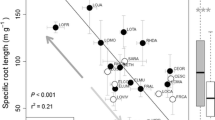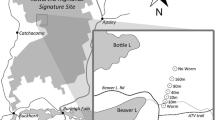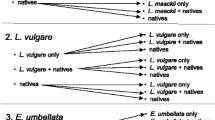Abstract
Non-native, invasive plants are often strong competitors that have large effects on ecosystem functioning. While limited experimental evidence suggests invasive species can change soil carbon (C) and nitrogen (N) processes, little is known about how they alter biogeochemistry in the field. We examined soils collected from beneath native and non-native, invasive woody plants in a temperate forest in central New York, USA, to test whether invaders change rhizospheric C and N processes compared to that of common native species. We hypothesized that a combination of high-quality leaf and root litter and greater rates of rhizospheric deposition of invaders would enhance the quality of soil organic matter, leading to greater measured rates of C and N mineralization. We removed soil cores from directly below the canopy of 105 individuals of 8 native and 3 invasive species of shrubs and small trees, each paired with an adjacent sample to account for site effects on soil properties. We measured inorganic N pools, percent soil C and N, and potential C and N mineralization rates with 10-day laboratory incubations. Contrary to our hypothesis, we found that invaders did not significantly alter any of the measured soil traits. Instead, root biomass per sample, which did not vary by nativity, was a better predictor of potential mineralized C and N. This suggests plant tissue quantity controls available C and N pools, and plants that produce more roots are able to better stimulate microbial activity. Thus, understory invaders do not appear to alter soil biogeochemistry in this forest unless they drive large changes in forest root mass.




Similar content being viewed by others
References
Ashton IW, Hyatt LA, Howe KM et al (2005) Invasive species accelerate decomposition and litter nitrogen loss in a mixed deciduous forest. Ecol Appl 15:1263–1272
Bardgett RD, Wardle DA (2010) Aboveground—belowground linkages: biotic interactions, ecosystem processes, and global change. Oxford University Press, Oxford
Bardgett RD, Bowman WD, Kaufmann R, Schmidt SK (2005) A temporal approach to linking aboveground and belowground ecology. Trends Ecol Evol 20:634–641
Bennett JA, Klironomos J (2019) Mechanisms of plant–soil feedback: interactions among biotic and abiotic drivers. New Phytol 222:91–96
Castro-Díez P, González-Muñ AN, Alonso AA et al (2009) Effects of exotic invasive trees on nitrogen cycling: a case study in Central Spain. Biol Invasions 11:1973–1986
Castro-Díez P, Godoy O, Alonso A et al (2014) What explains variation in the impacts of exotic plant invasions on the nitrogen cycle? A meta-analysis. Ecol Lett 17:1–12
Cheng W, Parton WJ, Gonzalez-Meler MA, Phillips R, Asao S, McNickle GG, Jastrow JD (2014) Synthesis and modeling perspectives of rhizosphere priming. New Phytol 201:31–44
Craine JM, Wedin DA, Chapin FS (1999) Predominance of ecophysiological controls on soil CO2 flux in a Minnesota grassland. Plant Soil 207:77–86
De Long JR, Jackson BG, Wilkinson A et al (2019) Relationships between plant traits, soil properties and carbon fluxes differ between monocultures and mixed communities in temperate grassland. J Ecol 107:1704–1719
DeMeester JE, Richter D (2010) Differences in wetland nitrogen cycling between the invasive grass Microstegium vimineum and a diverse plant community. Ecol Appl 20:609–619
Dijkstra FA, Cheng W (2007) Interactions between soil and tree roots accelerate long-term soil carbon decomposition. Ecol Lett 10:1046–1053
Dreiss LM, Volin JC (2013) Influence of leaf phenology and site nitrogen on invasive species establishment in temperate deciduous forest understories. For Ecol Manag 296:1–8
Drenovsky RE, Martin CE, Falasco MR, James JJ (2008) Variation in resource acquisition and utilization traits between native and invasive perennial forbs. Am J Bot 95:681–687
Ehrenfeld JG (2003) Effects of exotic plant invasions on soil nutrient cycling processes. Ecosystems 6:503–523
Ehrenfeld JG (2010) Ecosystem consequences of biological invasions. Annu Rev Ecol Evol Syst 41:59–80
Essl F, Milasowszky N, Dirnböck T (2011) Plant invasions in temperate forests: resistance or ephemeral phenomenon? Basic Appl Ecol 12:1–9
Farrar J, Hawes M, Jones D, Lindow S (2003) How roots control the flux of carbon to the rhizosphere. Ecology 84:827–837
Freschet GT, Aerts R, Cornelissen JHC (2012) Multiple mechanisms for trait effects on litter decomposition: moving beyond home-field advantage with a new hypothesis. J Ecol 100:619–630
Fridley JD (2012) Extended leaf phenology and the autumn niche in deciduous forest invasions. Nature 485:359–362
Funk JL (2013) The physiology of invasive plants in low-resource environments. Conserv Physiol 1:1–17
Funk JL, Vitousek PM (2007) Resource-use efficiency and plant invasion in low-resource systems. Nature 446:1079–1081
Grotkopp E, Rejmánek M (2007) High seedling relative growth rate and specific leaf area are traits of invasive species: phylogenetically independent contrasts of woody angiosperms. Am J Bot 94:526–532
Hamilton EA, Frank DA, Hinchey PM, Murray MR (2008) Grazer-induced increases in root exudation trigger positdpive feedbacks in a temperate grassland. Soil Biol Biochem 40:2865–2873
Heberling JM, Fridley JD (2013) Resource-use strategies of native and invasive plants in Eastern North American forests. New Phytol 200:523–533
Heberling JM, Fridley JD (2016) Invaders do not require high resource levels to maintain physiological advantages in a temperate deciduous forest. Ecology 97:874–884
Henneron L, Cros C, Picon-Cochard C, Rahimian V (2019) Plant economic strategies of grassland species control soil carbon dynamics through rhizodeposition. J Ecol. https://doi.org/10.1111/1365-2745.13276
Isaac SR, Nair MA (2005) Biodegradation of leaf litters in the warm humid tropics of Kerala, India. Soil Biol Biochem 37:1656–1664
Jo I, Fridley JD, Frank DA (2015) Linking above- and belowground resource use strategies for native and invasive species of temperate deciduous forests. Biol Invasions 17:1545–1554
Jo I, Fridley JD, Frank DA (2016) More of the same? In situ leaf and root decomposition rates do not vary between 80 native and nonnative deciduous forest species. New Phytol 209:115–122
Jo I, Fridley JD, Frank DA (2017) Invasive plants accelerate nitrogen cycling: evidence from experimental woody monocultures. J Ecol 105:10–15
Johnson D, Leake JR, Ostle N, Ineson P, Read DJ (2002) In situ 13CO2 pulse-labelling of upland grassland demonstrates a rapid pathway of carbon flux from arbuscular mycorrhizal mycelia to the soil. New Phytol 153:327–334
Krishna MP, Mohan M (2017) Litter decomposition in forest ecosystems: a review. Energy Ecol Environ 2:236
Kuebbing SE, Classen AT, Call JJ et al (2015) Plant–soil interactions promote co-occurrence of three nonnative woody shrubs. Ecology 96:2289–2299
Kuzyakov Y (2002) Review: factors affecting rhizosphere priming effects. J Plant Nutr Soil Sci 165:382–396
Kuzyakov Y, Cheng W (2001) Photosynthesis controls of rhizosphere respiration and organic matter decomposition. Soil Biol Biochem 33:1915–1925
Leishman M, Haslehurst T, Ares A, Baruch Z (2007) Leaf trait relationships of native and invasive plants: community- and global-scale comparisons. New Phytol 176:635–643
Liao C, Peng R, Luo Y et al (2008) Altered ecosystem carbon and nitrogen cycles by plant invasion: a meta-analysis. New Phytol 177:706–714
Martin PH, Canham CD, Marks PL (2009) Why forests appear resistant to exotic plant invasions: intentional introductions, stand dynamics, and the role of shade tolerance. Front Ecol Environ 7:142–149
Martinez KA, Fridley JD (2018) Acclimation of leaf traits in seasonal light environments: are non-native species more plastic? J Ecol 106:2019–2030
Pinheiro J, Bates D, DebRoy S, Sarkar D, R Core Team (2019) nlme: linear and nonlinear mixed effects models. R package version 3.1 140. https://CRAN.Rproject.org/package=nlme
R Core Team (2018) R: A language and environment for statistical computing. R Foundation for Statistical Computing, Vienna, Austria. URL https://www.R-project.org/
Richardson DM, Rejmánek M (2011) Trees and shrubs as invasive alien species–a global review. Divers Distrib 17:788–809
Robertson GP, Coleman DC, Bledsoe CS, Phillip S (1999) Standard soil methods for long-term ecological research. Oxford University Press, New York
Schuster MJ, Dukes JS (2014) Non-additive effects of invasive tree litter shift seasonal N release: a potential invasion feedback. Oikos 123:1101–1111
Stanford G, Carter JN, Smith SJ (1974) Estimates of potentially mineralizable soil nitrogen based on short-term incubations. Soil Sci Soc Am J 38:99
Tamura M, Tharayil N (2014) Plant litter chemistry and microbial priming regulate the accrual, composition and stability of soil carbon in invaded ecosystems. New Phytol 203:110–124
Tan KH (2009) Environmental soil science, 3rd edn. Taylor & Francis Group, Florida
Van Kleunen M, Weber E, Fischer M (2010) A meta-analysis of trait differences between invasive and non-invasive plant species. Ecol Lett 13:235–245
Vilà M, Espinar JL, Hejda M et al (2011) Ecological impacts of invasive alien plants: a meta-analysis of their effects on species, communities and ecosystems. Ecol Lett 14:702–708
Wolfe BE, Rodgers VL, Stinson KA, Pringle A (2008) The invasive plant Alliaria petiolata (garlic mustard) inhibits ectomycorrhizal fungi in its introduced range. J Ecol 96:777–783
Zagal E (1994) Influence of light intensity on the distribution of carbon and consequent effects on mineralization of soil nitrogen in a barley (Hordeum vulgare L.) soil system. Plant Soil 160:21–31
Zhang P, Li B, Wu J, Hu S (2019) Invasive plants differentially affect soil biota through litter and rhizosphere pathways: a meta-analysis. Ecol Lett 200:200–210
Acknowledgments
We thank T. and R. Starmer for access to field sites, J. Lamit and B. Elliot for field assistance, J.Cestra, A. Ebert, and N. Mohanbabu for laboratory assistance, and R. Yanai for project advice.
Author information
Authors and Affiliations
Corresponding author
Additional information
Publisher's Note
Springer Nature remains neutral with regard to jurisdictional claims in published maps and institutional affiliations.
Electronic supplementary material
Below is the link to the electronic supplementary material.
Rights and permissions
About this article
Cite this article
Hull, V., Frank, D. & Fridley, J.D. Woody invaders do not alter rhizosphere microbial activity in a temperate deciduous forest. Biol Invasions 22, 2599–2608 (2020). https://doi.org/10.1007/s10530-020-02273-x
Received:
Accepted:
Published:
Issue Date:
DOI: https://doi.org/10.1007/s10530-020-02273-x




